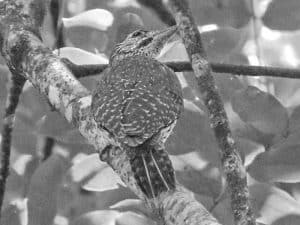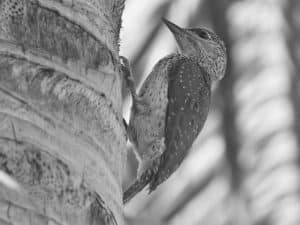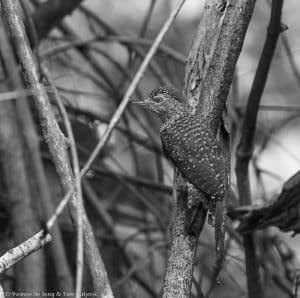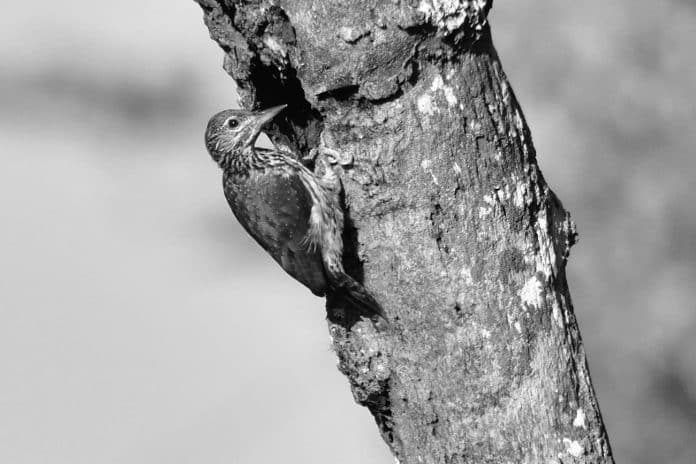Introduction to the Mombasa Woodpecker
The Mombasa Woodpecker, scientifically known as Campethera mombassica, is a stunning bird species that can be found along the beautiful shores of Tanzania. With its vibrant plumage and distinct drumming sounds, the Mombasa Woodpecker in Tanzania is a true gem of the coastal region. This article will delve into the habitat, distribution, physical characteristics, and behavior of the Mombasa Woodpecker, shedding light on its importance in the ecosystem and the conservation efforts being made to protect this remarkable bird.
Habitat and Distribution of the Mombasa Woodpecker in Tanzania

The Mombasa Woodpecker primarily inhabits the coastal woodlands and forests of Tanzania. These lush habitats provide the perfect environment for the woodpecker to thrive. From the mangroves to the acacia woodlands, the Mombasa Woodpecker can be spotted tapping away on tree trunks in search of food. Its distribution spans from the northern regions of Tanzania, such as Tanga, all the way down to the southern parts, like Lindi. This wide range showcases the adaptability of the Mombasa Woodpecker to various coastal ecosystems.
Physical Characteristics and Behavior of the Mombasa Woodpecker
The Mombasa Woodpecker is a medium-sized bird, measuring around 25 centimeters in length. It has a striking appearance, with a black head adorned with a crimson crest. Its back is a beautiful shade of green, while the underparts are a mix of pale yellow and black. The male and female woodpeckers share a similar appearance, making it difficult to distinguish between the sexes.
As their name suggests, woodpeckers are known for their drumming behavior. The Mombasa Woodpecker uses its strong bill to create a rhythmic tapping sound on tree trunks. This drumming serves multiple purposes, including communication, territorial defense, and foraging. By listening to the distinct drumming patterns, experienced birdwatchers can identify the presence of the Mombasa Woodpecker in the area.
Importance of the Mombasa Woodpecker in the Ecosystem
The Mombasa Woodpecker plays a crucial role in the coastal ecosystem of Tanzania. As a primary cavity excavator, it creates holes in trees that serve as nesting sites for various bird species. These cavities are also used by other animals such as bats and small mammals. By providing nesting opportunities, the Mombasa Woodpecker contributes to the biodiversity and overall health of the ecosystem.
Furthermore, the Mombasa Woodpecker helps control insect populations. Its diet mainly consists of wood-boring insects, ants, and beetles. By feeding on these pests, the woodpecker helps maintain a natural balance in the ecosystem, preventing outbreaks of harmful insects that could potentially damage the trees and surrounding vegetation.
Conservation Efforts for the Mombasa Woodpecker
Despite its significance in the ecosystem, the Mombasa Woodpecker faces various threats to its survival. Habitat loss due to deforestation, urbanization, and agricultural expansion poses a significant risk. Climate change and the resulting alteration of coastal ecosystems also impact the woodpecker’s habitat and food availability.
To protect the Mombasa Woodpecker and its habitat, conservation organizations and local communities are working together. Initiatives such as reforestation projects, establishment of protected areas, and raising awareness about the importance of woodpecker conservation have been implemented. By supporting these efforts, we can ensure the long-term survival of the enchanting Mombasa Woodpecker.
Interesting Facts about the Mombasa Woodpecker

- The Mombasa Woodpecker gets its name from the city of Mombasa in Kenya, where it was first discovered.
- It is known for its distinctive drumming sound, which can be heard up to 500 meters away.
- The Mombasa Woodpecker has a specialized tongue that wraps around its brain to protect it from the constant impact of drumming.
- Unlike other woodpecker species, the Mombasa Woodpecker does not have a stiff tail, allowing it to maneuver more easily in dense coastal vegetation.
- These woodpeckers are monogamous and form strong pair bonds that last throughout their lives.
Birdwatching Tips for Spotting the Mombasa Woodpecker
If you’re eager to catch a glimpse of the magnificent Mombasa Woodpecker, here are some birdwatching tips to enhance your chances:
- Visit the coastal woodlands and forests of Tanzania, particularly areas with a high density of trees.
- Look for fresh cavities in tree trunks, indicating recent woodpecker activity.
- Listen for the distinctive drumming sound, which can help guide you to the woodpecker’s location.
- Be patient and observant, as the Mombasa Woodpecker may spend long periods of time in one area before moving on.
Remember to respect the woodpecker’s habitat and observe from a distance to minimize disturbance.
Other Woodpecker Species in Tanzania
Tanzania is home to a diverse range of woodpecker species, each with its own unique characteristics and distribution. Some notable woodpeckers found in Tanzania include the Bearded Woodpecker, Golden-tailed Woodpecker, and the Cardinal Woodpecker. Exploring the woodpecker diversity in Tanzania can be a rewarding experience for bird enthusiasts.
How to Support Woodpecker Conservation in Tanzania

If you’re inspired to contribute to woodpecker conservation in Tanzania, here are a few ways you can make a difference:
- Support local conservation organizations working on woodpecker research and habitat preservation through donations or volunteer work.
- Participate in citizen science projects that monitor woodpecker populations and contribute data to scientific research.
- Spread awareness about the importance of woodpecker conservation through social media, educational initiatives, and community outreach.
- Practice responsible ecotourism by engaging in birdwatching activities that prioritize the well-being of the woodpeckers and their habitats.
By taking these actions, you can help ensure a brighter future for not only the Mombasa Woodpecker but also the entire woodpecker community in Tanzania.
Conclusion: The Enchanting Presence of the Mombasa Woodpecker Along Tanzanian Shores
As you explore the picturesque shores of Tanzania, keep an eye out for the captivating Mombasa Woodpecker. Its vibrant plumage, rhythmic drumming, and vital ecological role make it an enchanting species to behold. Through conservation efforts and responsible tourism, we can protect the Mombasa Woodpecker and its habitat, ensuring that future generations can marvel at its presence along the Tanzanian shores. So, grab your binoculars, listen for the drumming sound, and embark on an unforgettable journey to discover the coastal charms of the Mombasa Woodpecker.

































